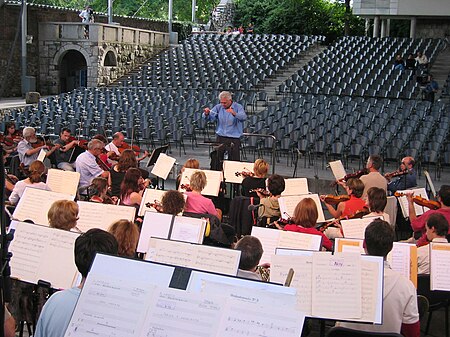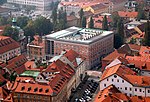Križanke

The Križanke Outdoor Theatre (Poletno gledališče Križanke) is a theatre in Ljubljana, Slovenia, used for summer festivals set up inside the courtyard of the former Monastery of the Holy Cross. It is located at French Revolution Square (Trg francoske revolucije) no. 1. It was created by Jože Plečnik in the 1950s within the confiscated former monastery especially for the Ljubljana Festival and the Secondary School for Design and Photography. Ljubljana Festival holds major events on the open-air stage, while other venues include the Baroque-style Križanke Church, the Knights' Hall (Viteška dvorana) and the Devil's Courtyard (Peklensko dvorišče). The amphitheatre-like southern courtyard with its large retractable canopy has since proved to be a superb venue for classical, jazz, and rock concerts. The venue is managed by the Festival Ljubljana Public Institute and is available for hire. The part of the former monastery premises, which is occupied by the Secondary School for Design and Photography, is used to host students interested in photography, graphics design, fashion, industrial arts and an art gymnasium. Because of the lack of space the school is also based on another location, on Roška cesta 2.
Excerpt from the Wikipedia article Križanke (License: CC BY-SA 3.0, Authors, Images).Križanke
Križevniška soteska, Ljubljana Trnovo
Geographical coordinates (GPS) Address Nearby Places Show on map
Geographical coordinates (GPS)
| Latitude | Longitude |
|---|---|
| N 46.046805555556 ° | E 14.503202777778 ° |
Address
Srednja šola za oblikovanje in fotografijo Ljubljana
Križevniška soteska
1102 Ljubljana, Trnovo
Slovenia
Open on Google Maps







